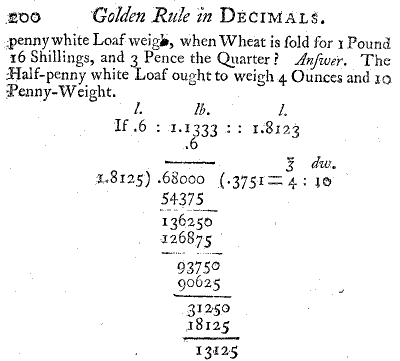UNDER DIVISION
HISTORY OF DIVISION SIGN
Close parenthesis. The arrangement 8)24 was used by Michael Stifel (1487-1567 or 1486-1567) in Arithmetica integra, which was completed in 1540 and published in 1544 in Nuernberg (Cajori vol. 1, page 269; DSB).
The colon (:) was used in 1633 in a text entitled Johnson Arithmetik; In two Bookes (2nd ed.: London, 1633). However Johnson only used the symbol to indicate fractions (for example three-fourths was written 3:4); he did not use the symbol for division "dissociated from the idea of a fraction" (Cajori vol. 1, page 276).
Gottfried Wilhelm Leibniz (1646-1716) used : for both ratio and division in 1684 in the Acta eruditorum (Cajori vol. 1, page 295).
The obelus (÷) was first used as a division symbol by Johann Rahn (or Rhonius) (1622-1676) in 1659 in Teutsche Algebra (Cajori vol. 2, page 211).
Here is the page in which the division symbol first appears in print, as reproduced in Cajori.
Rahn's book was translated into English and published, with additions by John Pell, in London in 1668, with the division symbol retained. According to some recent sources, John Pell was a major influence on Rahn and he may in fact be responsible for the invention of the symbol. However, according to Cajori there is no evidence to support this claim. The division symbol was used by many writers before Rahn as a minus sign.
Recent symbolism. In nineteenth century U. S. textbooks, long division is typically shown with the divisor, dividend, and quotient on the same line, separated by parentheses, as 36)116(3. See the figure below.

Division shown in Arithmetick by John Hill (1772)
This same 1772 book shows a vinculum above the dividend when dividing decimals:

Decimal division in Arithmetick by John Hill (1772)
In 1882 in Complete Graded Arithmetic by James B. Thomson, the 36)116(3 notation is used for long division. However, in examples for short division, a vinculum is placed under the dividend and the vinculum is almost attached to the bottom of the close parenthesis. The quotient is written under the vinculum, as shown below.

From Complete Graded Arithmetic, 1882
In 1888 in the teacher's edition of The Elements of Algebra by G. A. Wentworth the vinculum is almost attached to the top of the close parenthesis and the quotient is written above the vinculum, as shown below.

From Elements of Algebra, 1888
The symbolism shown above may also appear in the earlier 1882 edition of Wentworth, which has not been seen. I welcome earlier uses of this symbol that may be found by readers of this page.
In 1901, the second edition of Robinson's Complete Arithmetic by Daniel W. Fish uses the same notations for short and long division as Thomson (1882) above, except that the vinculum under the dividend is actually attached to the close parenthesis. This notation may appar in the earlier 1873 edition, which has not been seen.
David E. Smith writes, "It is impossible to fix an exact date for the origin of our present arrangement of figures in long division, partly because it developed gradually" (Smith vol. 2).
The symbol  is not mentioned by Cajori. The symbol does not have a name.
is not mentioned by Cajori. The symbol does not have a name.

